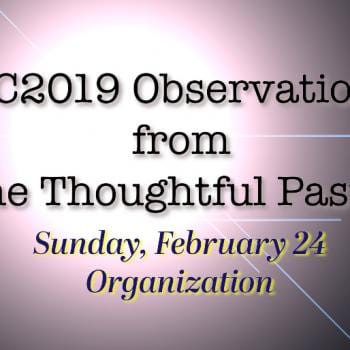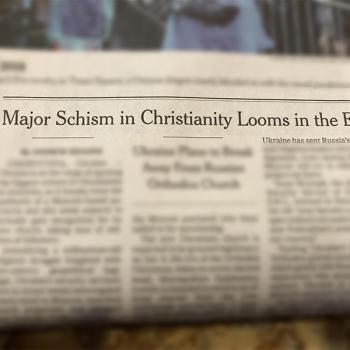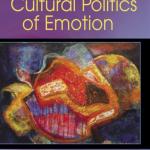The question appears again and again in church life and right now particularly with mainline denominations: should we just give up and split up?
There is a way to divide and still thrive. Let’s pay attention to the lesson from the garden here.
In 2012, I wrote a post about the now-impossibility of actually reforming the death-giving structure of The United Methodist Church. My frustration emerged after the Judicial Council, doing exactly what they are supposed to do, put the final nail in the coffin by overturning several significant votes taken at out 2012 General Conference.
The big challenge, besides our structure, are the multiple theologies held by varying United Methodists. One of the UMC’s great strengths has long been its wide umbrella gathering many under its shelter. That wide umbrella now threatens to self-destruct as theologies that should be informing and sharpening one another now say with greater frequency: “You are no longer with the trouble. Just get out. ”
But I say today: we must not give up and split up. To do so denies the transforming power of the Gospel that all of us seek to uphold.
To say to one another, “Our disagreements are so great that I no longer wish to stay in connection with you,” says to the world, already prepared to condemn the church for its poor ability to create anything approaching heavenly harmony, “Yep, pretty well everything we say to you is a lie.”
Let us not be liars. We are called to be vessels of life-giving truth.
The Healthy Division
However, as a gardener as well as years as a pastor, I think there is a healthy division. This division brings vibrant new life.
As with many gardens, my flower and vegetable beds display a mix of annuals and perennials.
We plant annuals each year. Ideally, and if not using hybrids, the plants produce well for a year, and then set some seeds for rebirth the following year. Life to death and back to life again, that beautiful cycle.
Part of church life consist of “annuals,” short-term efforts that produce fruit and then die and then have the seeds resown as necessary or have the beds cleared for the next short-term effort.
But the larger church functions also functions like perennials, which come back year after year adding new growth without the necessity of resowing seed. Eventually, however, all perennials get so intertwined and stuck together that only the act of dividing them gives them opportunity of new life. Otherwise, they begin to die from the core outward. The tight core can’t let in light and fertilizer. They stop blooming.
Most gardeners I know take immense pleasure in dividing their perennials and giving them away. The flower beds at the church I served last are almost entirely populated with donated perennials. Those plants are a testament to the life-giving process of division and separation.
The image at the top of this post shows a daylily bloom just about ready to offer its flowering beauty. That particular daylily plant is the third or even fourth division of the original plant. One plant has turned into at least 20 more, all related to each other.
There is some evidence that plants feel pain, so the divisions may have been painful. Each plant had to be forcibly removed from the ground, pried apart (sometimes with a sharp knife or even a hatchet depending on how long it has been since the last division) and replanted some distance away. Some of the divisions didn’t carry enough roots and withered away. Most sections, however, thrived and will in time be ready to divide again.

These elephant ears were four years old when I took this photo. I had planted seven bulbs originally. At least sixty to seventy have now come up where the original seven first took root.
At some point they, too, will have to be divided. Otherwise they will end up killing each other because of inadequate space to grow and inadequate light and water.
So what do lessons from the garden say to the church?
Exactly what we need to know: if we are going to stay alive for generations to come and continue to offer the beauty of grace, we must engage in healthy division practices WHILE staying connected by our DNA.
Right now, we function like a perennial that refuses to be dug up and broken apart. Our roots are intertwined and stuck together. Our core has become hard, tight, inflexible and unable to bring forth blooms or to find the energy to reproduce. Slowly, but with great surety, the entire plant, The United Methodist Church, will die without separation.
We must do an intentional division to survive, but a division that brings life to all parts of the divided plant. Let’s not leave some without adequate roots for thriving life.
Doctrinal Purity/Missional Relevance
But how do we do this? I so appreciate what Jeremy Smith has said here: Schism seeks to end the tension between doctrinal purity and missional relevance, but fails. There can be space in the UMC for both those who place doctrine above the human condition and those who place the human condition above doctrine.
We must not break into different denominations over these issues. We must find a way to strengthen that umbrella so there is room for both to be covered by grace underneath it.
Certainly, there is not going to be unified thinking or universal agreement in our connection particularly with regard to sexuality but also on many other issues.
Thanks be to God for that.
A place with unified thinking and universal agreement is a place where terror and mind-control rule.
Our over-arching rule is to be a place of life-giving love. That is how others will know we are Christians. They will see us love WHILE we disagree and fight and argue and make some healthy divisions so we can continue to grow and bloom and give life.
Those on the side of missional relevance need those who value doctrinal purity. Doctrine matters hugely. We are to be distinctively Christian. We are not an “anything goes” church.
Those who value doctrinal purity must learn to find their humility in the mystery of God and grace and recognize that doctrinal purity at its core leads to practices like the Inquisition. When the need for purity is not balanced with deep humility and awareness that all human decisions about the nature of God are deeply limited and always flawed, that need brings death without hope of resurrection.
So, yes, we must divide. No, we must not split or let schism rule.
We need to stay United Methodists. United in love, in the core of our Wesleyan understanding, and held together by the bonds of grace that remind us that while we were yet sinners, Christ died for us. That proves God’s love for us.
In the name of Jesus Christ, we are forgiven. Glory to God. Amen.


















